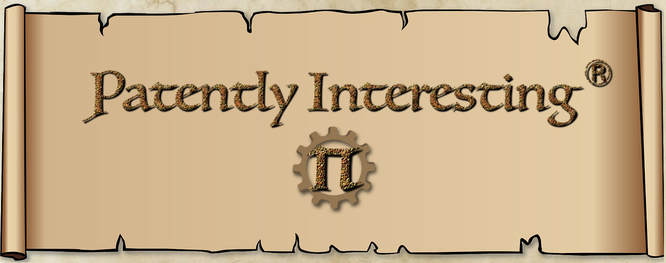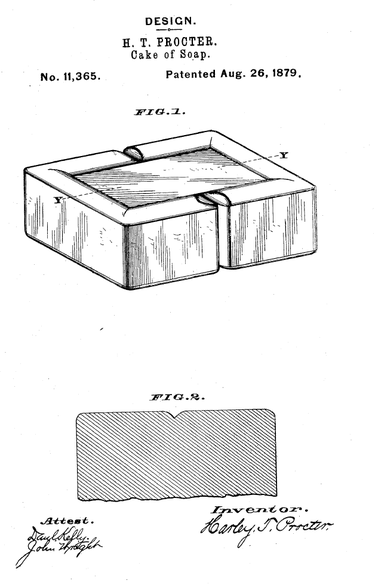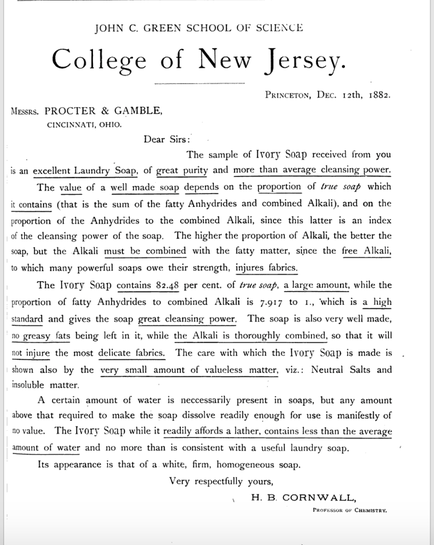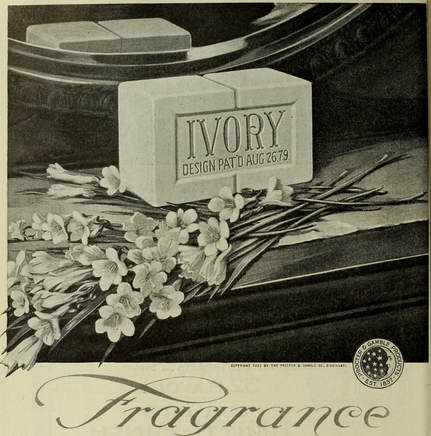 Magazine Advertisement for Ivory soap
Magazine Advertisement for Ivory soap
On August 26 of the year 1879, U.S. Design Patent No.: 11,365 issued to Harley T. Procter for "Cake of Soup". The design was for Ivory® soap, which the Procter & Gamble Company (P&G) of Cincinnati started selling in 1879. In addition to its unique design, the Ivory® soap cake was more pure than conventional soap of the time and was able to float in water. All of these aspects of the the Ivory® soap cake were heavily marketed by P&G to quickly make Ivory® the leading soap brand in the nation. Indeed, it can be argued that Ivory® was the first national brand of any type of product. In establishing the brand, P&G pioneered new methods of marketing and advertising that are still used today.
Until the arrival of Ivory® soap in 1879, soap was a commodity product that was made from candle-making by-products and was sold by manufacturers to merchants in bulk. The merchants would cut up the soap and sell it to customers unwrapped or in non-descript packaging. P&G manufactured both candles and soap, but came to the realization that they needed to concentrate more on soap-making. In accordance with this realization, P&G began to develop a new type of soap. The man who helped formulate the new soap was James Norris Gamble, who was the son of founder James Gamble. James N. Gamble was a trained chemist who developed an inexpensive white soap that was equal in quality to the expensive Castile soap imported from Europe. What he created would later become Ivory® soap.
According to the Ivory® soap myth that held sway for more than a hundred years, the unique aspect of Ivory® soap that enabled it to float was the result of an accident. Allegedly, in 1879, a workman accidently left a stirring machine running during his lunch break, which caused excess air to be whipped into the batch of soap that was being produced. The result was an airy cake of soap that could float in water. Not wanting to throw the soap away, P&G decided to sell the soap. To their surprise, the buoyant soap was an instant success.
It was not until 2004 that the truth came out. While doing research for an upcoming book on P&G, an archivist at P&G found a lab notebook in which a chemist noted: "I made floating soap today. I think we'll make all of our stock that way." The chemist who made the entry was none other than James Norris Gamble. And the date of the entry was 1863, which was more than 16 years before P&G started selling Ivory® soap.
While it was James N. Gamble who created Ivory® soap in the physical sense, it was Harley Procter who created it in the brand sense. Harley Procter was the son of the other founder of P&G, William Procter. He was a deeply religious man and, as the story goes, had an epiphany about P&G's new white soap after reading Psalm 45 one Sunday morning while attending church. In particular, Harley seized upon the word "ivory" from the portion of Psalm 45 that read: “All thy garments smell of myrrh, and aloes, and cassia, out of the ivory palaces, whereby they have made thee glad.” Then and there Harley decided that “ivory” would be the name for P&G's new white soap since it reminded him of purity, which was a fitting association for soap.
Until the arrival of Ivory® soap in 1879, soap was a commodity product that was made from candle-making by-products and was sold by manufacturers to merchants in bulk. The merchants would cut up the soap and sell it to customers unwrapped or in non-descript packaging. P&G manufactured both candles and soap, but came to the realization that they needed to concentrate more on soap-making. In accordance with this realization, P&G began to develop a new type of soap. The man who helped formulate the new soap was James Norris Gamble, who was the son of founder James Gamble. James N. Gamble was a trained chemist who developed an inexpensive white soap that was equal in quality to the expensive Castile soap imported from Europe. What he created would later become Ivory® soap.
According to the Ivory® soap myth that held sway for more than a hundred years, the unique aspect of Ivory® soap that enabled it to float was the result of an accident. Allegedly, in 1879, a workman accidently left a stirring machine running during his lunch break, which caused excess air to be whipped into the batch of soap that was being produced. The result was an airy cake of soap that could float in water. Not wanting to throw the soap away, P&G decided to sell the soap. To their surprise, the buoyant soap was an instant success.
It was not until 2004 that the truth came out. While doing research for an upcoming book on P&G, an archivist at P&G found a lab notebook in which a chemist noted: "I made floating soap today. I think we'll make all of our stock that way." The chemist who made the entry was none other than James Norris Gamble. And the date of the entry was 1863, which was more than 16 years before P&G started selling Ivory® soap.
While it was James N. Gamble who created Ivory® soap in the physical sense, it was Harley Procter who created it in the brand sense. Harley Procter was the son of the other founder of P&G, William Procter. He was a deeply religious man and, as the story goes, had an epiphany about P&G's new white soap after reading Psalm 45 one Sunday morning while attending church. In particular, Harley seized upon the word "ivory" from the portion of Psalm 45 that read: “All thy garments smell of myrrh, and aloes, and cassia, out of the ivory palaces, whereby they have made thee glad.” Then and there Harley decided that “ivory” would be the name for P&G's new white soap since it reminded him of purity, which was a fitting association for soap.
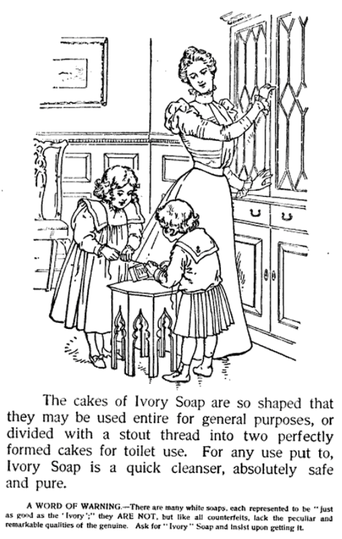
In addition to coining the name for Ivory® soap, Harley also created the design for the Ivory® soap cake, which was the subject of the '365 design patent. The design included a rectangular body with top and bottom surfaces that were each surrounded by a raised, peripheral ridge. The ridges, on the top and bottom, were each interrupted by a pair of depressions or clefts that extended into opposing sides of the body. The clefts were formed to facilitate breaking the soap cake into two pieces. This feature was promoted in P&G's advertisements for Ivory® soap, as shown to the right.
Another innovation that Harley made was in the marketing and advertisement of Ivory® soap. At the time, most products were not individually branded and the marketing for products was directed to the merchants who sold the products. Harley changed that by introducing the Ivory® brand and marketing Ivory® soap directly to the end consumer. He used large advertisements in magazines and other periodicals. These advertisements included testimonials from customers, as well as prominent chemists (see below).
Harley's marketing and advertising of Ivory® soap soon made it a houshold name. To this day, Ivory® soap is a well-known national brand.
Another innovation that Harley made was in the marketing and advertisement of Ivory® soap. At the time, most products were not individually branded and the marketing for products was directed to the merchants who sold the products. Harley changed that by introducing the Ivory® brand and marketing Ivory® soap directly to the end consumer. He used large advertisements in magazines and other periodicals. These advertisements included testimonials from customers, as well as prominent chemists (see below).
Harley's marketing and advertising of Ivory® soap soon made it a houshold name. To this day, Ivory® soap is a well-known national brand.

